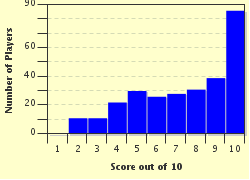Quiz Answer Key and Fun Facts
1. The last specimen of which now extinct animal died at the Hobart Zoo in 1936?
2. Believed to have been extinct since the 1960s, where was the last Yallara seen in the wild?
3. The last known Barbary lion in the wild was killed by a hunter in which North African mountain range?
4. The last specimen of which of the following antelopes died in the Paris Zoo in 1923?
5. The last Round Island Burrowing Boa was seen in 1975 on which of the following island nations, which was also home to the extinct Dodo bird?
6. Which of the following was a zebra-like animal which became extinct on August 12th, 1883, at a zoo in The Netherlands?
7. The introduction of the European fox to the country of Australia has caused, or contributed greatly to, the extinction of over a dozen native species.
8. What was the main cause of extinction of the Javan Tiger last seen in 1972?
9. Declared extinct in 2000 the Pyrenean Ibex was what kind of animal?
10. In 2011, the western black rhinoceros was declared extinct.
Source: Author
dcpddc478
This quiz was reviewed by FunTrivia editor
gtho4 before going online.
Any errors found in FunTrivia content are routinely corrected through our feedback system.

